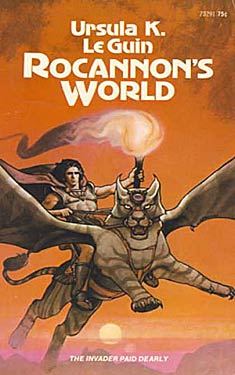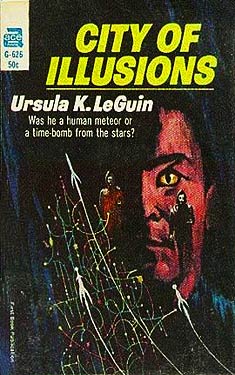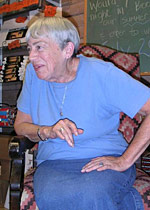Outside the Norm: Ursula K. Le Guin’s Rocannon’s World and City of Illusions
Rhonda Knight is an Associate Professor of English at Coker College in Hartsville, SC. She teaches Medieval and Renaissance literature as well as composition courses. When she looked over last year’s reading list, she was shocked to see that only 17% of the authors she read were women. This blog will record her attempts to read authors that are generally considered out of the science fiction norm: women, persons of color, and non-U.S. and non-U.K. authors.
 When Rocannon’s World, Planet of Exile and City of Illusions were reprinted in the mid-1970s, Ursula K. Le Guin wrote introductions for each novel. Those introductions contain two passages that tell you everything that you need to know about Rocannon’s World and City of Illusions:
When Rocannon’s World, Planet of Exile and City of Illusions were reprinted in the mid-1970s, Ursula K. Le Guin wrote introductions for each novel. Those introductions contain two passages that tell you everything that you need to know about Rocannon’s World and City of Illusions:
Most of my stories are excuses for a journey. (We shall henceforth respectfully refer to this as the Quest Theme.) I never did care much about plots, all I want is to go from A to B—or, more often, from A to A—by the most difficult and circuitous route. (“Introduction to City of Illusions” in The Language of the Night 147)
And:
But of course fantasy and science fiction are different, just as red and blue are different; they have different frequencies; if you mix them (on paper—I work on paper) you get purple, something else again. Rocannon’s World is definitely purple. (“Introduction to Rocannon’s World” in The Language of the Night 133)
Both novels are about planetary outsiders who must go on a quest. Rocannon, the ethnologist studying Fomalhaut II, is the sole survivor of his expedition group. An unknown alien race blows up his ship and his companions. The destruction of the ship eliminates his mode of communication; therefore, he can’t tell his people that the planet has been attacked. He has no way to protect the indigenous people. Traveling south to the base of the enemy to use their communication equipment to contact his people is his only option. Rocannon assembles a Tolkiensque group, and they begin their quest. The beats of their journey closely resemble Joseph Campbell’s monomyth, outlined in The Hero with a Thousand Faces. There are helpers, threshold guardians, tests, and even a bit of apotheosis. (Another good website about the monomyth is here.)
Falk’s journey in City of Illusions is a quest to learn who he is. The novel opens with Falk’s discovery by an agrarian society. He has no memory, no language. They foster him and teach him their ways, but he is not of their species. He has amber, cat-like eyes that mark him as alien. After living with these people for five years, his instinct tells him that he must journey west toward the legendary city of Es Toch to learn who he is. Unlike Rocannon, he usually travels alone, but like Rocannon, he encounters tests, helpers and threshold guardians along the way.
 I enjoyed the “purpleness” of both novels as they placed the quest myth on unknown, or at least immediately unrecognizable, planets, whose cultures would be at home in high fantasy. In Rocannon’s World, Le Guin enlivens Norse myth with a slice of Tolkien. The Liuar species who travel with Rocannon has two classes: the Olgyior, who are the servants, and the Angyar, who are the lords. They live within a “feudal-heroic culture,” which Le Guin sums up this way: “They were a boastful race, the Angyar: vengeful, overweening, obstinate, illiterate, and lacking any first-person forms for the verb ‘to be unable.’ There were no gods in their legends, only heroes” (4, 37).
I enjoyed the “purpleness” of both novels as they placed the quest myth on unknown, or at least immediately unrecognizable, planets, whose cultures would be at home in high fantasy. In Rocannon’s World, Le Guin enlivens Norse myth with a slice of Tolkien. The Liuar species who travel with Rocannon has two classes: the Olgyior, who are the servants, and the Angyar, who are the lords. They live within a “feudal-heroic culture,” which Le Guin sums up this way: “They were a boastful race, the Angyar: vengeful, overweening, obstinate, illiterate, and lacking any first-person forms for the verb ‘to be unable.’ There were no gods in their legends, only heroes” (4, 37).
Also, on the planet are the Gdemiar, who had a dwarfish culture before the Hainish envoys enhanced their culture to an industrial level, and the Fiia, who live an elvish, agrarian lifestyle. The Fian, Kyo, who has lost his whole village, joins the quest, giving the reader an insight into that culture that we don’t with the Gdemiar.
In City of Illusions Falk’s journey across a post-apocalyptic North American continent exposes him to many cultures we would see in fantasy novels. There are extended-family agrarians, hunter-gatherers, Taoist hermits, and isolationists, all of whom have developed rituals that suit their cultural needs. The isolationists are the Bee-Keepers, “[a] strange lot, literate and laser armed, all clothed alike, men and women, in long shifts of yellow wintercloth marked with a brown cross on the breast” (277).  While they treat Falk well, he learns that they capture outside women solely to breed more Bee-Keepers and “worship something called the Dead God, and placate him with sacrifice—murder” (278). Each group Falk encounters serves as either helpers or hinderers on his journey, just as they should in a good quest myth.
While they treat Falk well, he learns that they capture outside women solely to breed more Bee-Keepers and “worship something called the Dead God, and placate him with sacrifice—murder” (278). Each group Falk encounters serves as either helpers or hinderers on his journey, just as they should in a good quest myth.
The characters and ideas expressed in City of Illusions are much more complex than those in Rocannon’s World. Le Guin’s Taoism is much more pronounced as she queries the difference between truth and lies throughout Falk’s journey. The characters and situations are much more gray than the starker black and white of Rocannon’s World. However, I enjoyed reading Rocannon’s World much more. I liked Rocannon more than Falk, perhaps because Falk is a mystery through most of the book. Both books give us a glimpse of the writer that Le Guin will become. We see her world-building, her fascinating cultures, and her wonderful prose.



















 Full Details
Full Details


1 Comment
Aha, the launch of the Hainish Cycle! Entertaining novels, even though a little inferior to her later work. As you say, "a glimpse of the writer [she] will become." Despite the haphazard approach to science and myth in these novels, still very much Le Guin. And that in itself is enough!
Sorry, the comment form is closed at this time.